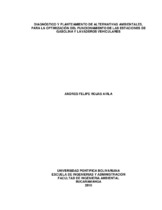Mostrar el registro sencillo del ítem
Diagnóstico y planteamiento de alternativas ambientales, para la optimización del funcionamiento de las estaciones de gasolina y lavaderos vehiculares
| dc.contributor.advisor | Castillo Meza, Luis Eduardo | |
| dc.contributor.author | Rojas Avila, Andres Felipe | |
| dc.coverage.spatial | Seccional Bucaramanga. Universidad Pontificia Bolivariana. Escuela de Ingenierías. Facultad de Ingeniería Ambiental | spa |
| dc.coverage.temporal | 2010 | |
| dc.date.accessioned | 2013-08-28T16:59:36Z | |
| dc.date.available | 2013-08-28T16:59:36Z | |
| dc.date.created | 2010-08-05 | |
| dc.date.issued | 2013-08-28 | |
| dc.identifier.uri | http://hdl.handle.net/20.500.11912/850 | |
| dc.description | 195p.: (pdf); il; gráficas; tablas | spa |
| dc.description.abstract | En este trabajo se presentan los diseños de los sistemas de tratamiento de aguas residuales, construidos para el manejo de los residuos líquidos generados en las zonas de islas, lavaderos vehiculares, cafeterías y baños de 3 Estaciones De Servicio (EDS), las cuales para efectos de confidencialidad fueron denominadas EDS ESTACIÓN 1, EDS ESTACIÓN 2 y EDS ESTACIÓN 3. Las estaciones de servicio EDS ESTACIÓN 1, EDS ESTACIÓN 2 y EDS ESTACIÓN 3, se encuentran localizadas en los municipios de San Alberto, Aguachica y Pelaya respectivamente. En el interior de las tres estaciones referidas se realizan actividades generadoras de residuos líquidos; razón por la cual se hizo necesario establecer alternativas para el manejo de las aguas residuales, teniendo en cuenta que los sistemas de tratamiento existentes se encontraban en estado de saturación y se estaban realizando vertimientos directos sobre cuerpos de agua y alcantarillados municipales. Con el objetivo de plantear las alternativas, se estableció una metodología de trabajo dividida en tres fases: Durante la fase preliminar se realizaron vistas técnicas a las tres EDS, se recopiló y evaluó la información existente, se efectuó una revisión bibliográfica en lo referente a normatividad ambiental vigente y posibles trenes de tratamiento a proponer. La fase de diseño y construcción, consistió en realizar el ajuste, rediseño y posterior construcción de las unidades de tratamiento para cada una de las zonas generadoras de residuos líquidos. Finalmente en la fase de verificación, se llevó a cabo la caracterización de cada uno de los sistemas, se elaboro documento técnico en el que se estableció que las tres EDS se encontraban en cumplimiento de la normatividad vigente, y por tanto se iniciaba el trámite de otorgamiento del permiso de vertimientos en beneficio de cada uno de los establecimientos referidos. | spa |
| dc.description.abstract | This paper presents the design of wastewater treatment systems, constructed to handling the liquid waste generated in island areas, vehicle washing, cafeterias and restrooms of 3 gas oil stations, which for purposes of Privacy were called EDS STATION 1, EDS STATION 2 and EDS STATION 3. The gas oil stations EDS ESTACION 1, EDS ESTACION 2 and EDS ESTACION 3, are located in the municipalities of San Alberto, Aguachica and Pelaya respectively. Inside each gas oil station mentioned different kinds of activities generates wastewater. For that reason it was necessary to set alternatives for the wastewater treatment, taking in to account that existing systems depuration were found saturated and doing direct discharges into water bodies and municipal sewer. It was established a methodology divided in three different phases with the objective to handle the waste water, generated by each of the gas oil stations. The first was the preliminary phase, during this one all the stations were visited, it was made the collection and evaluation of existing information, a literature review related with the actual environmental regulation and possible treatments trains to propose. In the period of the design and construction phase, it was made the redesigning and subsequent construction of treatment units, for each one of the areas, in where generate wastewater inside the gas oil stations like islands area, vehicle washing, cafeterias and bathrooms. Finally at the verification phase, it was carried out the characterization of each of the systems constructed, for the evaluation it was made a technical paper in where was established that the gas oil stations EDS ESTACION 1, EDS ESTACION 2 and EDS ESTACION 3 were in compliance with the of decree 1594 of 1984, and in that way began the process of awarding the dumping permit for the benefit of each of the establishments referred. | spa |
| dc.language.iso | es | |
| dc.publisher | Universidad Pontificia Bolivariana | spa |
| dc.rights | Attribution-NonCommercial-NoDerivatives 4.0 International | * |
| dc.rights.uri | http://creativecommons.org/licenses/by-nc-nd/4.0/ | * |
| dc.subject | Ingeniería ambiental | spa |
| dc.subject | Aguas residuales | spa |
| dc.subject | Lavaderos vehiculares | spa |
| dc.subject | Residuos líquidos | spa |
| dc.title | Diagnóstico y planteamiento de alternativas ambientales, para la optimización del funcionamiento de las estaciones de gasolina y lavaderos vehiculares | spa |
| dc.type | workingPaper | spa |
| dc.rights.accessRights | openAccess | spa |
| dc.type.hasVersion | publishedVersion | spa |
| dc.identifier.instname | instname:Universidad Pontificia Bolivariana | spa |
| dc.identifier.reponame | reponame:Repositorio Institucional de la Universidad Pontificia Bolivariana | spa |
| dc.identifier.repourl | repourl:https://repository.unab.edu.co/ |
Ficheros en el ítem
Este ítem aparece en la(s) siguiente(s) colección(ones)
-
Trabajos de grado [6698]
Monografías, artículos, informes, proyecto de grado


